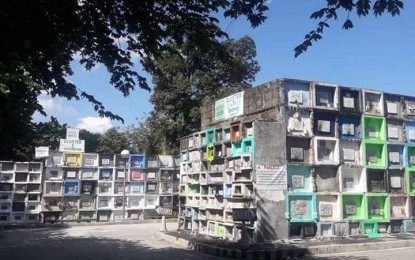Lifestyle
Cemeteries, memorial parks abound in Novaliches

CEMETERIES, MEMORIAL PARKS. Shown in photo is a section of the old Novaliches public cemetery with apartment niches. Novaliches has concentration of 11 cemeteries and memorial parks within a diameter of less than 20 kilometers.
(Photo by Severino C. Samonte)
MANILA — Where in the country can you find a single place with concentration of 11 cemeteries and memorial parks within a diameter of less than 20 kilometers?
Go to Novaliches, a former town now divided between Quezon City and Caloocan City in the northernmost periphery of Metropolitan Manila bounding with Central Luzon’s Bulacan province.
At present, there are five big memorial parks (mild term for cemeteries) and six cemeteries –five public and one private– located in Novaliches, a town created during the Spanish regime in the Philippines in 1855.
Three of the five memorial parks are located in the Quezon City portion of Novaliches, and the two others in the Caloocan section.
Of the five public cemeteries, three are in Novaliches, Quezon City, and the two others are in the Caloocan territory.
The three memorial parks in the QC area are the Holy Cross Memorial Park along Quirino Highway in Barangay San Bartolome; the Himlayang Pilipino Memorial Park in Barangay Pasong Tamo; and the Eternal Gardens, also along Quirino Highway in Barangay Baesa-Balonbato off the North Luzon Expressway.
The two memorial parks in the Novaliches-Caloocan area are the Forest Memorial Park in Barangay Bagumbong and the Serenity Memorial Park in neighboring Barangay Deparo.
The oldest among these memorial parks was the Holy Cross Memorial Park which was established in early 1960s.
Prior to the establishment of similar memorial parks in the nearby towns (now cities) of Valenzuela, Meycauayan and San Jose del Monte in Bulacan, affluent families in these areas were burying their dead relatives at the Holy Cross Memorial Park.
On the other hand, the public cemeteries in Novaliches, QC are the Novaliches Catholic Cemetery along Gen. Luis St. in Barangay San Agustin; the Bagbag Cemetery along Quirino Highway in Barangay Bagbag; and the Baesa-Sangandaan Cemetery, also along Quirino Highway. The oldest among these three was the Novaliches Catholic Cemetery which was established in 1927.
The two public cemeteries in the Caloocan portion are the Bagbaguin Cemetery along Gen. Luis St. in Barangay Bagbaguin and the Tala Cemetery in Barangay Bagong Silang, considered as the biggest barangay in the country today in terms of population and land area.
The lone private cemetery in Novaliches is the Jesuits cemetery at the compound of the Sacred Heart Novitiate and Seminary along Quirino Highway in Barangay Pasong Putik Proper, just off the Quezon City-Caloocan boundary near the La Mesa Dam.
Among those buried in the Jesuits cemetery were noted priest-historian Fr. Horacio dela Costa, Ramon Magsaysay Awardee for Journalism Fr. James Reuters, and activist doctor-priest Fr. Romeo “Archie” Intengan.
There is no exact figure of the number of people buried in these memorial parks and cemeteries in Novaliches, but it is safe to say that they exceed the million-mark.
One thing sure is that the presence of these burial grounds in the area is creating grave traffic problems in Novaliches every time All Saints’ Day and All Souls’ Day are observed.
Needless to say, most of the people visiting their dead relatives in the five memorial parks on Oct. 31, Nov. 1 and 2 are car owners whose vehicles move bumper-to-bumper along the roads leading to Novaliches, particularly along Quirino Highway from Balintawak, Tandang Sora Ave., C-5/Mindanao Ave., Gen. Luis St., and Commonwealth Ave.
History shows that Novaliches was created as a town of the province of Bulacan during the Spanish regime on Sept. 22, 1855. It was composed of the estates or “hacienda” of Malinta, Payatas, Tala, and Piedad.
According to the book, “Ang Kasaysayan ng Novaliches” (History of Novaliches) written and published in 1997 by the historian mother-and-son team, Prof. Rosalina M. Franco-Calairo and Dr. Emmanuel Franco Calairo, when the province of Manila was created in 1858, all the towns of the then province of Tondo, including Caloocan, were incorporated with the new Manila province.
In the same year, the town of Novaliches was weaned from Bulacan province and annexed to the province of Manila. This arrangement prevailed until the outbreak of the 1896 revolution against Spain.
At the end of the Spanish-Filipino and American-Filipino wars (1896-1901), the successor American rulers created the Philippine Commission to reorganize the local governments in their new territory.
One of the first acts of the commission was the creation of Rizal province out of the political-military district of Morong.
Aside from the towns in the Morong district, the new province of Rizal annexed some towns from Manila province, including the neighboring Caloocan and Novaliches, under Philippine Commission Act No. 137.
On Oct. 12, 1903, the same commission approved Act No. 942, reducing the 32 towns of Rizal province to just 15 for the purpose of economy. As a result, the existing towns of Caloocan and Novaliches were merged, with Caloocan as the seat of government.
Novaliches remained as a barrio of Caloocan until Republic Act No. 333 was passed by Congress in July 1948, making the then nine-year-old Quezon City as the national capital of the Philippines in lieu of Manila.
That congressional move resulted in the division of Novaliches between Quezon City and Caloocan City.
In 1976, then President Ferdinand E. Marcos amended Republic Act 333 and returned Manila as the country’s capital through a presidential decree.
However, the divisive state of Novaliches remains.





















